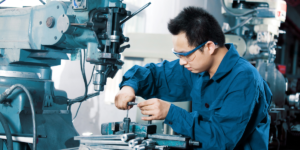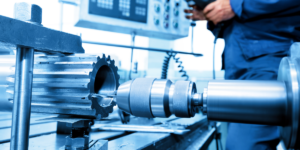
Precision tops the list of priorities in CNC machining since being off by a few thousandths is enough to cause serious errors. While no machine yields a 100% accuracy rate, specific approaches have been undertaken to manufacture components efficiently and economically.
Tolerancing exists because we cannot, nor have we ever been able to produce “perfect” parts. Everything, no matter what it is, must have a tolerance.
Different Machining Tolerances
Here are five types of tolerances in different products that vary depending on the material, temperature, and other factors:
- Size tolerances: the physical limit of size of the features machined on the part
- Form tolerances: Basic yet crucial, geometric tolerance designs and shapes the part’s form or shape.
- Profile tolerances: set up a boundary around a surface to contain the elements of the surface.
- Orientation tolerances: This type of tolerance determines the orientation of the surface or feature in reference to a datum feature.
- Location tolerances: A location tolerance reveals the feature’s location with respect to a reference datum features on a part.
Standards that Define Machining Tolerances
Different materials and machining processes have varying tolerance values, implying that there is no standard machining tolerance value that works for all. However, some machinists and manufacturers have established standards for specific applications.
While some machining shops ask customers to provide specific tolerance values, others will often pick a standard tolerance of, for instance ±0.005, if you do not provide a precise value. This value indicates that the diameter of the manufactured part might be 0.005″ smaller or bigger compared to the specified diameter.
A machinist will determine a specific process or procedure of processes based off of the tolerance requirements. The tolerance stated on the drawing is all that’s available so they must determine how to “process” the part in order to meet the tolerance requirements. Here are some examples of what needs to be considered:
- Nature of Material: No two materials are identical, with some being easier to mold and manufacture than others. Certain factors such as hardness, rigidity, abrasiveness, and heat stability of the material influence tolerance values.
- Machining Methods: The machining process used in manufacturing can significantly affect the end product since some processes deliver higher accuracy and precision than others.
- Expenditures and Budget: Tighter tolerances drive up the manufacturing costs enormously. If the client is on a budget, the best way to ensure cost-efficiency is to have precise tolerance that is tight enough to get the job done.
- Finishes and Plating: Finishing and plating add minuscule amounts of material to the part’s surface, which can lead to dimensional alterations of the part where it might change its tolerance value. The treatment of the part may add or subtract material.

The Significance of Tolerancing for Machinists
Different parts have varying tolerances, some being strict while others have a higher margin for error. Machinists only proceed to the next step of cutting the material with a CNC mill if they have the specific tolerances available.
GD&T provides a clear, unambiguous dimensional range to the manufacturer, which tells the limits of the part features until it ceases to function optimally.
Here are some factors that state the significance of tolerancing in the manufacturing sector –
- Enhanced Fit and Part Functionality:
If your company manufactures parts that work with other components, it is crucial to define your dimensional and geometric dimensioning and tolerancing. Even a minor mismeasurement or size variation will leave your product redundant for the market.
- Minimized Ambiguity and Complexity:
Ambiguity is detrimental to the manufacturing process. You must specify your GD&T requirements before the manufacturing process to ensure that the end product gets customized to your liking.
Tolerances can help machinists by minimizing ambiguity and simplifying the manufacturing process. For instance, if your desired end-product does not require high tolerance values such as ±0.002mm, machinists can deliver the part in less time and charge you significantly less.
- Room for Error:
Tolerances assume a certain level of error to be present in the end product such that the part maintains functionality. Defining tolerances right from the beginning of the manufacturing phase will ensure you do not have to worry about remaking all components from scratch.
- A Cost-Effective Solution:
Defining your product’s tolerances means you will only have to pay for the raw materials, workforce, and manufacturing tools required to achieve the result. Specific dimensional and geometric tolerancing let you skip paying for extreme precision when your end part can function on looser tolerances.
- No Delays in Market Launches:
While it might get somewhat time-consuming to devise tolerances up front, it will be worth every second in the long run as you will save ample time. Mismeasurements and inconsistent productions can move your market launch date and time by a considerable period while you await new parts getting manufactured.
- Improved Visual Appeal:
Several manufacturing firms care about the visual appeal of the part, which can be enhanced by accounting for tight tolerances. This is more of a significant factor than most realize. Consider a surface that came out with a 500Ra due to massive chatter compared to another that came out with a 32Ra. If a designer can live with 500Ra, then it should be stated on a drawing to avoid Quality or the Machinist rejecting the part.

Final Words
No industrial sector delivers 100% accuracy in the end product; thus, deviation from the ideal is inherent in almost all manufactured components. Tolerances help control such variations by maintaining consistency and adequate part performance.
Tolerances can help save the needless capital investment that might go into part rebuilding, alterations, and other miscellaneous activities performed to fix a part built wrongly with unacceptable dimensional values. It improves accuracy, reduces cost, leaves no room for market launch delays, and enhances the visual appeal of the end product.
About the Author:
 Peter Jacobs is the Senior Director of Marketing at CNC Masters. He is actively involved in manufacturing processes and regularly contributes his insights to various blogs on CNC machining, 3D printing, rapid tooling, injection molding, metal casting, and manufacturing in general.
Peter Jacobs is the Senior Director of Marketing at CNC Masters. He is actively involved in manufacturing processes and regularly contributes his insights to various blogs on CNC machining, 3D printing, rapid tooling, injection molding, metal casting, and manufacturing in general.
Be The Go-To Engineer at Your Company
Learn GD&T at your own pace and apply it with confidence in the real world.
GET GD&T TRAINING